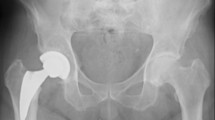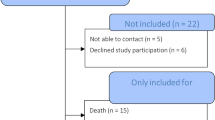Abstract
Introduction
To report clinical and radiographic outcomes of revision total hip arthroplasty (THA) through the direct anterior approach (DAA) using primary stems.
Materials and methods
The authors assessed a consecutive series of revision THAs operated by DAA using primary (cemented and uncemented) stems between 1/1/2010 and 30/06/2017. The initial cohort comprised 47 patients (50 hips), aged 65 ± 10 years with BMI of 25 ± 4 kg/m2. Clinical assessment included modified Harris Hip Score (mHHS) and satisfaction with surgery. Radiographic assessment included radiolucent lines > 2 mm, bone remodelling, cortical hypertrophy, pedestal formation, and osteolysis. Linear regression analyses were performed.
Results
Of the 50 hips (47 patients) in the initial cohort, intraoperative complications that did not require re-revision occurred in 5 hips. At a follow-up of > 2 years: 5 hips (10%) were lost to follow-up and 3 hips (6%) required stem re-revision, leaving a final cohort of 42 hips (40 patients). Postoperative complications that did not require re-revision occurred in 4 hips (8%). At 4.3 ± 1.6 years, post-revision mHHS was 89 ± 14 (range 47–100) and 38 patients were satisfied or very satisfied with revision surgery. Bone remodelling was observed in 8 hips (16%), cortical hypertrophy in 6 hips (12%), grade I heterotopic ossification in 7 hips (14%), and grade II in 1 hip (2%). There were no cases of radiolucent lines, pedestal formation, or osteolysis. Regression analyses revealed that post-revision mHHS was not associated with any variable.
Conclusions
Revision THA performed through the DAA using primary stems grants satisfactory clinical and radiographic outcomes at a minimum follow-up of two years.






Similar content being viewed by others
Data availability
Data can be requested from the corresponding author.
References
Baba T, Homma Y, Jinnai Y, Tanabe H, Banno S, Watari T et al (2020) Posterior versus direct anterior approach in revision hip arthroplasty using Kerboull-type plate. Sicot j 6:2
Thaler M, Dammerer D, Leitner H, Lindtner RA, Nogler M (2020) Mid-term follow-up of the direct anterior approach in acetabular revision hip arthroplasty using a reconstruction cage with impaction grafting. J Arthroplasty 35(5):1339–1343
Mast NH, Laude F (2011) Revision total hip arthroplasty performed through the Hueter interval. J Bone Joint Surg Am 93(Suppl 2):143–148
Kennon R, Keggi J, Zatorski LE, Keggi KJ (2004) Anterior approach for total hip arthroplasty: beyond the minimally invasive technique. J Bone Joint Surg Am 86(2):91–97
Cavagnaro L, Formica M, Basso M, Zanirato A, Divano S, Felli L (2018) Femoral revision with primary cementless stems: a systematic review of the literature. Musculoskelet Surg 102(1):1–9
Kelly SJ, Incavo SJ, Beynnon B (2006) The use of a hydroxyapatite-coated primary stem in revision total hip arthroplasty. J Arthroplasty 21(1):64–71
Salemyr MF, Skoldenberg OG, Boden HG, Ahl TE, Adolphson PY (2008) Good results with an uncemented proximally HA-coated stem in hip revision surgery: 62 hips followed for 2–13 years. Acta Orthop 79(2):184–193
Gastaud O, Cambas PM, Tabutin J (2016) Femoral revision with a primary cementless stem. Orthop Traumatol Surg Res 102(2):149–153
Della Valle CJ, Paprosky WG (2004) The femur in revision total hip arthroplasty evaluation and classification. Clin Orthop Relat Res 420:55–62
Migaud H, Ala Eddine T, Demondion X, Jardin C, Laffargue P, Dujardin F et al (2000) Classification of bone loss: reproducibility of classifications and lesion groupings. Rev Chir Orthop Reparatrice Appar Mot 86(Suppl 1):38–42
Manrique J, Chen AF, Heller S, Hozack WJ (2014) Direct anterior approach for revision total hip arthroplasty. Ann Transl Med 2(10):100
Jia F, Guo B, Xu F, Hou Y, Tang X, Huang L (2019) A comparison of clinical, radiographic and surgical outcomes of total hip arthroplasty between direct anterior and posterior approaches: a systematic review and meta-analysis. Hip Int 29(6):584–596
Wang Z, Hou JZ, Wu CH, Zhou YJ, Gu XM, Wang HH et al (2018) A systematic review and meta-analysis of direct anterior approach versus posterior approach in total hip arthroplasty. J Orthop Surg Res 13(1):229
Rodriguez JA, Deshmukh AJ, Rathod PA, Greiz ML, Deshmane PP, Hepinstall MS et al (2014) Does the direct anterior approach in THA offer faster rehabilitation and comparable safety to the posterior approach? Clin Orthop Relat Res 472(2):455–463
Sariali E, Leonard P, Mamoudy P (2008) Dislocation after total hip arthroplasty using Hueter anterior approach. J Arthroplasty 23(2):266–272
Siguier T, Siguier M, Brumpt B (2004) Mini-incision anterior approach does not increase dislocation rate: a study of 1037 total hip replacements. Clin Orthop Relat Res 426:164–173
Bremer AK, Kalberer F, Pfirrmann CW, Dora C (2011) Soft-tissue changes in hip abductor muscles and tendons after total hip replacement: comparison between the direct anterior and the transgluteal approaches. J Bone Joint Surg Br 93(7):886–889
Paprosky WG, Burnett RS (2002) Assessment and classification of bone stock deficiency in revision total hip arthroplasty. Am J Orthop 31(8):459–464
Brooker AF, Bowerman JW, Robinson RA Jr, Riley LH (1973) Ectopic ossification following total hip replacement. Incidence and a method of classification. J Bone Joint Surg Am 55(8):1629–1632
Engh CA, Massin P, Suthers KE (1990) Roentgenographic assessment of the biologic fixation of porous-surfaced femoral components. Clin Orthop Relat Res 257:107–128
Engh CA, Bobyn JD (1988) The influence of stem size and extent of porous coating on femoral bone resorption after primary cementless hip arthroplasty. Clin Orthop Relat Res 231:7–28
Dihlmann W, Dihlmann SW, Hering L (1991) Alloarthroplasty of the hip joint. Radiologic diagnosis of loosening and infection in cemented total endoprostheses. Radiologe 31(10):496–505
Melloh M, Eggli S, Busato A, Roder C (2011) Predictors of early stem loosening after total hip arthroplasty: a case-control study. J Orthop Surg (Hong Kong) 19(3):269–273
Austin PC, Steyerberg EW (2015) The number of subjects per variable required in linear regression analyses. J Clin Epidemiol 68(6):627–636
Pinaroli A, Lavoie F, Cartillier JC, Neyret P, Selmi TA (2009) Conservative femoral stem revision: avoiding therapeutic escalation. J Arthroplasty 24(3):365–373
Tetreault MW, Shukla SK, Yi PH, Sporer SM, Della Valle CJ (2014) Are short fully coated stems adequate for “simple” femoral revisions? Clin Orthop Relat Res 472(2):577–583
Thorey F, Lerch M, Kiel H, von Lewinski G, Stukenborg-Colsman C, Windhagen H (2008) Revision total hip arthroplasty with an uncemented primary stem in 79 patients. Arch Orthop Trauma Surg 128(7):673–678
Howie DW, Wimhurst JA, McGee MA, Carbone TA, Badaruddin BS (2007) Revision total hip replacement using cemented collarless double-taper femoral components. J Bone Joint Surg Br 89(7):879–886
Petrie MJ, Harrison TP, Buckley SC, Gordon A, Kerry RM, Hamer AJ (2017) Stay short or go long? Can a standard cemented femoral prosthesis be used at second-stage total hip arthroplasty revision for infection following an extended trochanteric osteotomy? J Arthroplasty 32(7):2226–2230
Stigbrand H, Ullmark G (2017) A 3- to 18-year follow-up of revision total hip arthroplasty with impacted bone allografts and cemented lubinus SP II stem. Clinical, radiographic, and survivorship analysis with comparison to the literature. J Arthroplasty 32(9):2810–2814
Gabor JA, Padilla JA, Feng JE, Schnaser E, Lutes WB, Park KJ et al (2020) Short-term outcomes with the REDAPT monolithic, tapered, fluted, grit-blasted, forged titanium revision femoral stem. Bone Joint J 102(2):191–197
Ngu AWT, Rowan FE, Carli AV, Haddad FS (2019) Single 3 degrees tapered fluted femoral stems demonstrate low subsidence at mid-term follow-up in severe bony deficiency. Ann Transl Med 7(23):725
Herry Y, Viste A, Bothorel H, Desmarchelier R, Fessy MH (2019) Long-term survivorship of a monoblock long cementless stem in revision total hip arthroplasty. Int Orthop 43(10):2279–2284
Busch CA, Charles MN, Haydon CM, Bourne RB, Rorabeck CH, Macdonald SJ et al (2005) Fractures of distally-fixed femoral stems after revision arthroplasty. J Bone Joint Surg Br 87(10):1333–1336
MacDonald SJ, Rosenzweig S, Guerin JS, McCalden RW, Bohm ER, Bourne RB et al (2010) Proximally versus fully porous-coated femoral stems: a multicenter randomized trial. Clin Orthop Relat Res 468(2):424–432
Crawford DA, Rutledge-Jukes H, Berend KR, Morris MJ (2019) Does a triple-wedge, broach-only stem design reduce early postoperative fracture in anterior total hip arthroplasty? Surg Technol Int 35:386–390
Eto S, Hwang K, Huddleston JI, Amanatullah DF, Maloney WJ, Goodman SB (2017) The direct anterior approach is associated with early revision total hip arthroplasty. J Arthroplasty 32(3):1001–1005
Janssen L, Wijnands KAP, Janssen D, Janssen M, Morrenhof JW (2018) Do stem design and surgical approach influence early aseptic loosening in cementless THA? Clin Orthop Relat Res 476(6):1212–1220
Meneghini RM, Elston AS, Chen AF, Kheir MM, Fehring TK, Springer BD (2017) Direct anterior approach: risk factor for early femoral failure of cementless total hip arthroplasty: a multicenter study. J Bone Joint Surg Am 99(2):99–105
Funding
This work was supported by ‘GCS Ramsay Santé pour l’Enseignement et la Recherche’, which provided funding for manuscript preparation and statistical analyses. GCS Ramsay Santé pour l’Enseignement et la Recherche, COS-RGDS-2019-12-003-LAUDE-F, Frederic Laude.
Author information
Authors and Affiliations
Corresponding author
Ethics declarations
Conflict of interest
MRVG, SRP, and MS have nothing to declare. FL declares royalties from Medacta.
Ethical approval
The present work was completed after being approved by an institutional review board (IRB: COS-RGDS-2019-12-003-LAUDE-F).
Informed consent
All patients provided informed consent for the use of their data and images for research and publishing purposes.
Additional information
Publisher's Note
Springer Nature remains neutral with regard to jurisdictional claims in published maps and institutional affiliations.
Rights and permissions
Springer Nature or its licensor (e.g. a society or other partner) holds exclusive rights to this article under a publishing agreement with the author(s) or other rightsholder(s); author self-archiving of the accepted manuscript version of this article is solely governed by the terms of such publishing agreement and applicable law.
About this article
Cite this article
Viamont-Guerra, MR., Ramos-Pascual, S., Saffarini, M. et al. Satisfactory clinical and radiographic outcomes following revision total hip arthroplasty by direct anterior approach using primary femoral stems at 2–8 years of follow-up. Arch Orthop Trauma Surg 143, 6393–6402 (2023). https://doi.org/10.1007/s00402-023-04838-6
Received:
Accepted:
Published:
Issue Date:
DOI: https://doi.org/10.1007/s00402-023-04838-6




